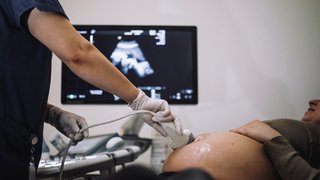‘I thought I was going to die’: Ashley’s postpartum hemorrhage story
August 13, 2019

Eight days after giving birth, Ashley Byrnes nearly died from postpartum hemorrhage (PPH) – excessive blood loss that can occur within 24 hours to 12 weeks after delivery.
PPH is the leading cause of maternal death worldwide. Most cases of PPH occur when, after delivery of the placenta, the uterus fails to contract enough to compress the bleeding blood vessels where the placenta was attached. This leads to uncontrolled bleeding, decreased blood pressure, and increased heart rate.
Though PPH affects 3 to 5 percent of new mothers, not all hospitals have specific, team-based procedures in place for managing obstetric hemorrhages. PPH causes approximately 8% of maternal deaths in developed countries such as the U.S. Some providers are not specifically trained in treating PPH and do not see cases of it often. These process and educational gaps trickle down to patients, leaving many women in the dark about the risks they might face when they go home.
Today, Ashley lives in the San Antonio area, and she advocates for patients and providers to receive more education about postpartum hemorrhage. Though UT Southwestern has specialized teams and procedures to handle PPH, we invited Ashley to share her moving story with our staff in July 2019 to reinforce the short- and long-term implications of how we educate and engage with patients under our care.
I encourage you to read Ashley's story and start a conversation about PPH with your doctor – and with a woman in your life.

Ashley’s story of postpartum hemorrhage
My son, Carter, was born July 18, 2017. The pregnancy was fairly easy. I was healthy, though I was classified as a high-risk pregnancy because of a few existing medical conditions. Other than a few fainting episodes, which turned out to be important later, everything was normal.
On delivery day, I was induced at 9:30 a.m. I had an epidural at 10:05 a.m. (thank goodness for those!), and Carter arrived at 7:47 p.m. I remember telling my husband, Bryan, “Having a baby was easy compared to how it looks on TV. I could totally do this again.”
Little did I know, I wouldn’t get the chance. After delivery, the nurses checked on me regularly and pushed on my stomach to release blood from my uterus. On the last day, the nurse didn’t push as much. I didn’t think much about it – I trusted they knew what was best, and I was focused on my new baby.
We went home when Carter was three days old. I was still bleeding, which is supposed to happen. Typical blood loss for a vaginal delivery is 500mL; for a cesarean section, it’s 1,000mL. The hospital at which I delivered didn’t give me that context. And honestly, it would be difficult to measure blood loss at home. In other words, I didn’t know I was losing too much blood.
Related reading: How much bleeding after delivery is normal?

‘Something is wrong with me’
Five days later, on my wedding anniversary, I started to feel...off. I’ll never forget that day. I lost my appetite, and I had an unshakeable feeling that something bad was about to happen.
While watching Bryan and our dog out in the yard, a surge of anxiety swept over me. I’m going to die. Something is wrong with me.
The awful sensation didn’t subside by evening, and Bryan took me to an emergency room near our house (not the hospital at which I’d delivered). We sat in the ER for eight grueling hours. Though I told the doctor I’d recently given birth, he didn’t do a pelvic exam. Instead, he suggested I was an overwhelmed new mother and sent me home.
The whole experience was frustrating, especially because I used to work in a children’s emergency room. I decided to get a second opinion.
I went to my Ob/Gyn the next day, but my regular doctor was out. The on-call doctor examined and said she didn’t find anything wrong. Then she asked if I was “bleeding enough.” As if I was supposed to know.
This doctor also said it was probably just my emotions. She suggested I come back and see my regular doctor the following week. At that point, I began to question myself. Two doctors had told me nothing was wrong. Maybe I’m just tired. Maybe I’m losing it.
‘Call 911’
The next night, after another unsuccessful attempt at making myself eat, I tried to relax and watch a movie with my mom. Suddenly I felt a massive gush between my legs. I rushed to the bathroom and discovered a blood clot the size of a pineapple in my pants.
Shock set in as I called for my mom. When she saw the aftermath, the color drained from her face. Wide-eyed, I mumbled, “What do I do?”
We called my Ob/Gyn’s office. It was after hours, so a nurse answered. We frantically explained what was wrong, and she told me to call back in 30 minutes if the bleeding didn’t stop.
I said, “Absolutely not. Call the doctor now and call me back.” The nurse didn't realize how bad the situation was. Apparently, neither did the on-call doctor, who suggested I lie down for a while and see if the blood loss would slow down. If it didn’t, he said, call 911.
Bryan had been at the gym, and he got home within an hour. I was still bleeding. He hopped in the shower quickly, and the last thing I remember was getting up to use the toilet. When Bryan got out of the shower, he found me passed out on the floor surrounded by enough blood to fill an IV bag. After a moment I came to, then looked at him and stammered, “Call 911."
When I woke up, eight emergency responders surrounded me. They packed me with massive diapers and loaded me into the ambulance. They gave me a drug that can stop bleeding when people are shot. It didn’t work. My blood pressure was dropping. “I need you to talk to me, Ashley,” one responder said. “I can’t have you fall asleep.”

‘No, I am not OK’
Blood rushed from my body as they transferred me into the ER. A trauma doctor was the first one to say the words “postpartum hemorrhage.” Then he said, “This happened to my wife. She was OK, and you will be, too.”
I remember thinking, “No, I am not OK.” He had good intentions, but he seemed too casual while I was bleeding out in front of him.
They rushed me into the trauma room where nurses surrounded me, giving me a blood transfusion and hooking me up to monitors. The attending Ob/Gyn looked exhausted. She did a vaginal ultrasound, verified I was hemorrhaging, and repeated that I would be fine.
Once I was somewhat stable, they moved me to the intensive care unit. I spent the night gushing blood. No one seemed to grasp the seriousness of the situation.
‘Just do it – give me the papers’
By the next morning, they had given me 19 bags of blood, four bags of plasma, and four bags of platelets. My blood type is O negative and the hospital supply was running low. So, they were giving me different combinations of blood, which threw off my body chemistry. I was a wreck.
When the Ob/Gyn came back around, she was shocked at my condition. She stood in the hall, talking with Bryan and my mom, who were both crying. Before they even came in, I had a gut feeling that hysterectomy was the only option to save my life.
The Ob/Gyn came to my bedside, nervous and teary. When she started to speak, I cut her off. “Just do it – give me the papers. I’m not even going to talk to my husband about this.” Then I told her to be calm. “You can’t operate on me if you’re nervous.”
I had the hysterectomy shortly thereafter. When I woke up, I learned the massive blood loss had damaged my kidneys and I would need to go on dialysis. My heart also was not functioning well.
I stayed in ICU for two weeks. My kidneys recovered after more than two weeks of dialysis, and I did more than two months of physical therapy to regain my strength. I was also diagnosed with post-traumatic stress disorder from the ordeal.
However, there was a silver lining. The trauma that almost killed me might have saved my life. Remember the early pregnancy fainting I mentioned? It turns out I had an underlying heart condition that wasn’t related to the hemorrhage, and I had to get a pacemaker. My cardiologist said if I had been able to conceive again, my heart likely would have failed during a second pregnancy.

An advocate for awareness, education
Every day for months after I was discharged from the ICU, I thought about what could have been done better. Truth be told, it all circles back to awareness and education.
If the providers were more aware of PPH, they would have identified the situation faster. And if they were more educated about PPH, they could have controlled the bleeding sooner.
Ideally, providers should share their awareness and education about PPH with their patients. When I looked back through my prenatal care paperwork, there was no mention of post-delivery trauma like PPH. As a first-time mom, I had no idea what to expect as far as bleeding and recovery.
So, I started talking about my experience with friends who were pregnant. Certainly, it’s more enjoyable to talk about baby names and food cravings. But women need to know about potential risks like PPH.
After we moved to the San Antonio area, I shared my story with Texas AIM. This maternal health advocacy initiative is a joint effort between the Department of State Health Services, the Texas Hospital Association, and the Alliance for Innovation on Maternal Health (AIM), a group that works toward consistent maternity care for PPH and other conditions. In July 2019, I was invited by, Jamie Morgan, M.D., at UT Southwestern to speak to the staff at Clements University Hospital about my experience.
Every time I tell my story, it’s a reminder to look for a silver lining. While it’s depressing that I won’t be able to carry another child, I know I’ve found my calling – helping educate women and providers so we can reduce maternal death and trauma from postpartum hemorrhage.

What women need to know about PPH
Ashley’s right – tough conversations are important. Providers must be realistic and honest about the potential risks involved with childbirth. We must remain calm and act quickly to get women appropriate care in obstetric emergencies.
And we must remember the long-term ramifications of these experiences. We care for patients for a short amount of time, but trauma can affect women for the rest of their lives.
While there has been some momentum regarding PPH education, the medical community still has work to do. Texas is one of 27 states that participate in AIM, which means we are collaborating with organizations across the U.S. to improve statewide maternal care.
UT Southwestern is an academic medical center, and we prioritize listening to our patients. We partner with Carter BloodCare, a local blood bank, to avoid transfusion crises like Ashley went through. And our doctors and nurses are trained to watch for signs of PPH – and educate women about their risks.
Postpartum hemorrhage can happen even if a woman has had smooth pregnancies and deliveries in the past. As a patient, never allow a doctor to disregard your concerns. Always trust your gut and persist when you know something is wrong.
Do you want to learn more about potential risks during and after childbirth? To visit with an Ob/Gyn, call 214-645-8300 or request an appointment online.











